.png.transform/rendition-xs/image_image%20(1).png)
Sobrasada de Mallorca PGI
Spreadable sausage obtained from minced pork mixed with pimentón (a type of Spanish paprika), salt and other authorized spices.
Tasting notes
Flavor that denotes a clear presence of pimentón (a type of Spanish paprika), a characteristic aroma, unctuous texture, non-fibrous, soft and non-elastic paste and a sticky, blended consistency.
Other notes
With an irregular cylindrical form (due to the gut in which it is wrapped), its exterior is smooth but with certain ruggedness, dark red in color and with no presence of mold. When cut, it has an intense red color.
The end product has the following physical and chemical characteristics:
-Maximum humidity: 35% for sobrasada de Mallorca and 30% for black pig sobrasada de Mallorca.
-Maximum fat over dry extract: 85% for sobrasada de Mallorca and 80% for black pig sobrasada de Mallorca.
-Maximum protein over dry extract: 8% for sobrasada de Mallorca and 13% for black pig sobrasada de Mallorca.
-Maximum total carbohydrates (expressed in glucose): 2.5% for both sobrasada de Mallorca and black pig sobrasada de Mallorca.
-Maximum total percentage of collagen over protein: 30 for sobrasada de Mallorca and 20 for black pig sobrasada de Mallorca.
Production / Processing method
Firstly, the pork is minced until particles with a diameter of less than 6 mm (0.02 in) are obtained, to which pimentón, salt and spices (such as pepper, rosemary, thyme and oregano) are added.
The mixture is mechanically kneaded until a homogenous dough is formed, which is then stuffed into natural gut.
The second stage, curing, is carried out in drying sheds, where the product will be cured for up to six months (depending on its size), to obtain the product’s unique physical, chemical and organoleptic characteristics.
The ingredients used must correspond to the following proportions:
-Lean: between 30% and 60%
-Fat: between 40% and 70%
-Pimentón (Capsicum annum L and/or Capsicum Longum D.C.): Between 4% and 6% Salt: between 1.8% and 2.8%
-Spices and/or natural aromas: pepper, rosemary, thyme and/or oregano
The addition of any kind of coloring agent, whether natural or artificial, is totally prohibited.
Geography / Relief and climate
Majorca is located in the center of the Balearic archipelago. With a surface area of 3,640 km2 (2,261 square miles) and 448 km (278 miles) of coast, it is the first island to form part of the Autonomous Community of the Balearic Islands.
The island has three distinct areas, as follows:
The Sierra Norte (or Sierra de Tramontana), which rises sharply from the sea and has the highest points on the island (Puig Mayor at 1,445 m (4,740 ft) and Masanella at 1,352 m (4,434 ft).
The Pla or Llano is the broad central depression, where main cultivation is carried out.
The Sierras de Levante are a collection of hills at the east and southeast of the island, with lower summits and smoother forms than those in the Sierra de Tramontana.
The Sierra Norte is formed of three superimposed folds, made up of Jurassic and Cretaceous limestone over shale from the Triassic, along with levels of conglomerates, detritic limestone and shale from the Miocene.
The Sierras de Levante have similar geographical formations, with shale or lime—shale materials from the Jurassic and Cretaceous periods.
The Pla has more modern land, ranging from the mid Miocene to the Quaternary period. The Miocene period left behind formations of shale, conglomerates, limestone and arsenic.
The area's climate is typically Mediterranean, with moderate temperatures and monthly averages of between 10 and 26 ºC (50 – 78.8 ºF), with slight thermal fluctuations.
Rainfall is between 425 and 550 mm (16.23 – 21.65 in), with an average of 70 – 80 days of rain. Summers have sharp droughts, partially mitigated by the area’s constant high humidity.
Relative humidity is both constant and high, with the exception of summer diurnal variations, which give minimums of 25% (with a yearly average of 69%). The highest monthly averages are in October and December, with the minimum in July.
The river system is made up of dry stream and ravine channels, through which water only flows after torrential rainfall. Lagoons and saltwater pools are located on the flat, low areas, including Alcudia, El Salobrar de Campos and Prat de Sant Jordi.
Regulatory Council
Consejo Regulador de la IGP Sobrasada de Mallorca
C/ Cuba, 2, bajos
07006 Palma de Mallorca
Illes Balears
Tel: (+34) 971 256 184
correo@sobrasadademallorca.org
www.sobrasadademallorca.org
Sources:
Its exterior is smooth but with certain ruggedness, dark red in color and with no presence of mold. When cut, it has an intense red color.


- /content/dam/en/icex-foodswines/images/products/serrano-cured-hams-charcuterie/sobrasada-de-mallorca-pgi/Sobrasada%20de%20Mallorca%20PGI%20carr1.jpg
- /content/dam/en/icex-foodswines/images/products/serrano-cured-hams-charcuterie/sobrasada-de-mallorca-pgi/Sobrasada%20de%20Mallorca%20PGI%20carr2.jpg

Palma de Mallorca (Balearic Islands)
